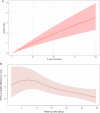Association between urea trajectory and protein dose in critically ill adults: a secondary exploratory analysis of the effort protein trial (RE-EFFORT)
- PMID: 38229072
- PMCID: PMC10792897
- DOI: 10.1186/s13054-024-04799-1
Association between urea trajectory and protein dose in critically ill adults: a secondary exploratory analysis of the effort protein trial (RE-EFFORT)
Abstract
Background: Delivering higher doses of protein to mechanically ventilated critically ill patients did not improve patient outcomes and may have caused harm. Longitudinal urea measurements could provide additional information about the treatment effect of higher protein doses. We hypothesised that higher urea values over time could explain the potential harmful treatment effects of higher doses of protein.
Methods: We conducted a reanalysis of a randomised controlled trial of higher protein doses in critical illness (EFFORT Protein). We applied Bayesian joint models to estimate the strength of association of urea with 30-day survival and understand the treatment effect of higher protein doses.
Results: Of the 1301 patients included in EFFORT Protein, 1277 were included in this analysis. There were 344 deaths at 30 days post-randomisation. By day 6, median urea was 2.1 mmol/L higher in the high protein group (95% CI 1.1-3.2), increasing to 3.0 mmol/L (95% CI 1.3-4.7) by day 12. A twofold rise in urea was associated with an increased risk of death at 30 days (hazard ratio 1.34, 95% credible interval 1.21-1.48), following adjustment of baseline characteristics including age, illness severity, renal replacement therapy, and presence of AKI. This association persisted over the duration of 30-day follow-up and in models adjusting for evolution of organ failure over time.
Conclusions: The increased risk of death in patients randomised to a higher protein dose in the EFFORT Protein trial was estimated to be mediated by increased urea cycle activity, of which serum urea is a biological signature. Serum urea should be taken into consideration when initiating and continuing protein delivery in critically ill patients.
Clinicaltrials: gov Identifier: NCT03160547 (2017-05-17).
Keywords: Intensive care; Joint modelling; Multi-organ failure; Protein; Urea.
© 2024. The Author(s).
Conflict of interest statement
DEB has received speaker fees, conference attendance support or advisory board fees from Baxter, Cardinal Health and Avanos. ZP has received honoraria for consultancy from GlaxoSmithKline, Lyric Pharmaceuticals, Faraday Pharmaceuticals and Fresenius-Kabi, educational support from Baxter and Nestle Health Science and speaker fees from Orion, Baxter, Sedana, Fresenius-Kabi and Nestle. JP has recent Consultancy agreements with Jaffron Biomedical, Mission Therapeutics, Paion Ltd., Nephrolyx GmbH, Medibeacon Inc., Baxter Inc and Nikkiso Europe GmbH, received speaker’s fees and hospitality from Baxter Inc, BBraun, Nikkiso Europe and Fresenius Medical Care and received research support from Astute Medical/ Biomerieux and Jaffron Biomedical. The remaining authors have no competing interest to declare.
Figures


Similar articles
-
The impact of higher protein dosing on outcomes in critically ill patients with acute kidney injury: a post hoc analysis of the EFFORT protein trial.Crit Care. 2023 Oct 18;27(1):399. doi: 10.1186/s13054-023-04663-8. Crit Care. 2023. PMID: 37853490 Free PMC article. Clinical Trial.
-
The effect of higher protein dosing in critically ill patients with high nutritional risk (EFFORT Protein): an international, multicentre, pragmatic, registry-based randomised trial.Lancet. 2023 Feb 18;401(10376):568-576. doi: 10.1016/S0140-6736(22)02469-2. Epub 2023 Jan 25. Lancet. 2023. PMID: 36708732 Clinical Trial.
-
Catabolism in Critical Illness: A Reanalysis of the REducing Deaths due to OXidative Stress (REDOXS) Trial.Crit Care Med. 2022 Jul 1;50(7):1072-1082. doi: 10.1097/CCM.0000000000005499. Epub 2022 Feb 28. Crit Care Med. 2022. PMID: 35220340 Clinical Trial.
-
The effects of higher versus lower protein delivery in critically ill patients: an updated systematic review and meta-analysis of randomized controlled trials with trial sequential analysis.Crit Care. 2024 Jan 6;28(1):15. doi: 10.1186/s13054-023-04783-1. Crit Care. 2024. PMID: 38184658 Free PMC article.
-
Pharmacokinetics of piperacillin and tazobactam in critically Ill patients treated with continuous kidney replacement therapy: A mini-review and population pharmacokinetic analysis.J Clin Pharm Ther. 2022 Aug;47(8):1091-1102. doi: 10.1111/jcpt.13657. Epub 2022 Mar 29. J Clin Pharm Ther. 2022. PMID: 35352374 Free PMC article. Review.
Cited by
-
Concurrent nutrition and physical rehabilitation interventions for patients with critical illness.Curr Opin Clin Nutr Metab Care. 2025 Mar 1;28(2):140-147. doi: 10.1097/MCO.0000000000001099. Epub 2024 Dec 16. Curr Opin Clin Nutr Metab Care. 2025. PMID: 39912392 Review.
-
Integrating Dynamic Red Blood Cell Distribution Width Monitoring and β-Blocker Therapy for Mortality Prediction in Intensive Care Unit Cardiomyopathy Patients: A Bayesian Multivariate Joint Model and Machine Learning Study.Diagnostics (Basel). 2025 May 14;15(10):1236. doi: 10.3390/diagnostics15101236. Diagnostics (Basel). 2025. PMID: 40428228 Free PMC article.
-
Augmented Enteral Protein During Critical Illness: The TARGET Protein Randomized Clinical Trial.JAMA. 2025 Jul 22;334(4):319-328. doi: 10.1001/jama.2025.9110. JAMA. 2025. PMID: 40495743 Clinical Trial.
-
Personalized Nutrition in the Pediatric ICU: Steering the Shift from Acute Stress to Metabolic Recovery and Rehabilitation.Nutrients. 2024 Oct 17;16(20):3523. doi: 10.3390/nu16203523. Nutrients. 2024. PMID: 39458517 Free PMC article. Review.
-
The urea-to-creatinine ratio as an emerging biomarker in critical care: a scoping review and meta-analysis.Crit Care. 2025 May 2;29(1):175. doi: 10.1186/s13054-025-05396-6. Crit Care. 2025. PMID: 40317012 Free PMC article.
References
-
- Heyland DK, Patel J, Compher C, et al. The effect of higher protein dosing in critically ill patients with high nutritional risk (EFFORT Protein): an international, multicentre, pragmatic, registry-based randomised trial. The Lancet. 2023;401:568–576. doi: 10.1016/S0140-6736(22)02469-2. - DOI - PubMed
Publication types
MeSH terms
Substances
Associated data
LinkOut - more resources
Full Text Sources
Medical

